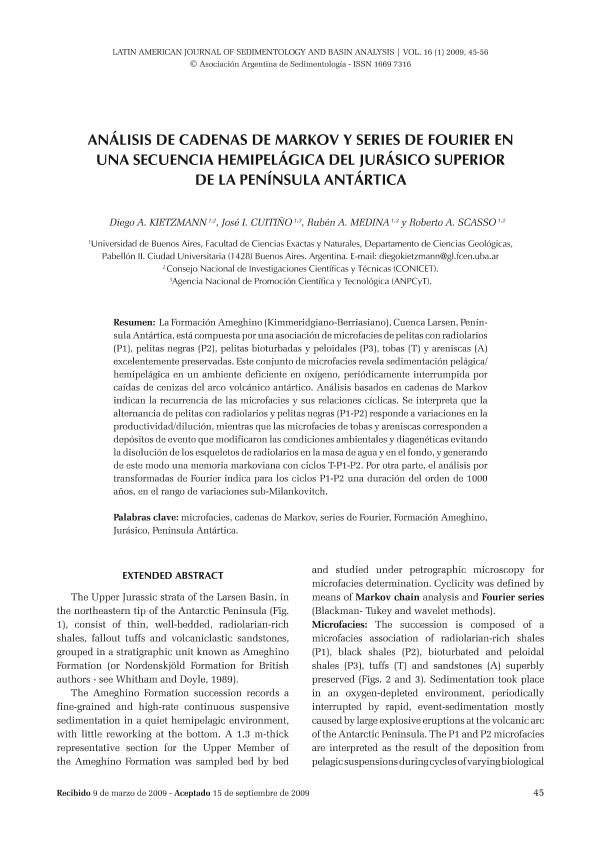Artículo
La Formación Ameghino (Kimmeridgiano-Berriasiano), Cuenca Larsen, Península Antártica, está compuesta por una asociación de microfacies de pelitas con radiolarios (P1), pelitas negras (P2), pelitas bioturbadas y peloidales (P3), tobas (T) y areniscas (A) excelentemente preservadas. Este conjunto de microfacies revela sedimentación pelágica/ hemipelágica en un ambiente deficiente en oxígeno, periódicamente interrumpida por caídas de cenizas del arco volcánico antártico. Análisis basados en cadenas de Markov indican la recurrencia de las microfacies y sus relaciones cíclicas. Se interpreta que la alternancia de pelitas con radiolarios y pelitas negras (P1-P2) responde a variaciones en la productividad/dilución, mientras que las microfacies de tobas y areniscas corresponden a depósitos de evento que modificaron las condiciones ambientales y diagenéticas evitando la disolución de los esqueletos de radiolarios en la masa de agua y en el fondo, y generando de este modo una memoria markoviana con ciclos T-P1-P2. Por otra parte, el análisis por transformadas de Fourier indica para los ciclos P1-P2 una duración del orden de 1000 años, en el rango de variaciones sub-Milankovitch. The Upper Jurassic strata of the Larsen Basin, in the northeastern tip of the Antarctic Peninsula (Fig. 1), consist of thin, well-bedded, radiolarian-rich shales, fallout tuffs and volcaniclastic sandstones, grouped in a stratigraphic unit known as Ameghino Formation (or Nordenskjöld Formation for British authors - see Whitham and Doyle, 1989).
The Ameghino Formation succession records a fine-grained and high-rate continuous suspensive sedimentation in a quiet hemipelagic environment, with little reworking at the bottom. A 1.3 m-thick representative section for the Upper Member of the Ameghino Formation was sampled bed by bed and studied under petrographic microscopy for microfacies determination. Cyclicity was defined by means of Markov chain analysis and Fourier series (Blackman- Tukey and wavelet methods).
Microfacies: The succession is composed of a microfacies association of radiolarianrich shales (P1), black shales (P2), bioturbated and peloidal shales (P3), tuffs (T) and sandstones (A) superbly preserved (Figs. 2 and 3). Sedimentation took place in an oxygen-depleted environment, periodically interrupted by rapid, event-sedimentation mostly caused by large explosive eruptions at the volcanic arc of the Antarctic Peninsula. The P1 and P2 microfacies are interpreted as the result of the deposition from pelagic suspensions during cycles of varying biological productivity or terrigenous dilution. The microfacies P3 represents similar conditions of sedimentation but higher oxygenation levels at the bottoms. On the other hand, microfacies T and A correspond to fallout deposits and distal turbiditic flows respectively. Microfacies T is associated with siliciclastic explosive volcanic eruptions and microfacies A with reworking of primary pyroclastic deposits.
Markov chain and Fourier series analysis: Markov chain analysis reveal cyclic relations between some microfacies with single step transition dependence (Figs. 4 and 5). Transition diagram shows statistically significant transitions from microfacies T and A to P1, between P1 and P2, and also a cycle T-P1-P2 (Fig. 6). Spectra from the Fourier series analysis on 37 pairs P1-P2 (Fig. 7 a) indicate a periodicity of 1140 years (Blackman-Tukey method, 95% confidence, Fig. 7b), and periodicities of 740 and 1160 years (wavelet method, Fig. 7c). Ages were derived from sedimentation rates calculated by Scasso (2001) for the Longing Member due to poor age determinations in the upper Member. A periodicity of about 1000 years may be associated with the Hallstatt cycle of solar activity that influence the intensity of solar radiation reaching the Earth and cause surface temperature variations within the sub-Milankovitch frequency band. A similar frequency was calculated by Scasso (2001) for large volcanic eruptions from the tuff record in the Longing Member. Therefore, P1- P2 transitions are associated to climatic cycles that influence productivity at the surface of the oceans. The accumulation of microfacies T and A are related to events of siliciclastic sedimentation that modified environmental and early-diagenetic conditions avoiding dissolution of radiolarian skeletons in the water body and at the bottom and caused the T and A transitions to P1. P2-T transition might indicate that P2 environmental conditions lasted longer than P1 conditions in spite of the similar thickness observed for both microfacies
Análsisis de cadenas de Markov y series de Fourier en una secuencia hemipelágica del Jurásico Superior, Peninsula Antártica
Fecha de publicación:
09/2009
Editorial:
Asociación Argentina de Sedimentología
Revista:
Latin American Journal of Sedimentology and Basin Analysis
ISSN:
1669-7316
e-ISSN:
1851-4979
Idioma:
Español
Tipo de recurso:
Artículo publicado
Clasificación temática:
Resumen
Archivos asociados
Licencia
Identificadores
Colecciones
Articulos(IDEAN)
Articulos de INSTITUTO DE ESTUDIOS ANDINOS "DON PABLO GROEBER"
Articulos de INSTITUTO DE ESTUDIOS ANDINOS "DON PABLO GROEBER"
Articulos(IGEBA)
Articulos de INSTITUTO DE GEOCIENCIAS BASICAS, APLICADAS Y AMBIENTALES DE BS. AS
Articulos de INSTITUTO DE GEOCIENCIAS BASICAS, APLICADAS Y AMBIENTALES DE BS. AS
Citación
Kietzmann, Diego Alejandro; Cuitiño, José Ignacio; Medina, Rubén Alberto; Scasso, Roberto Adrian; Análsisis de cadenas de Markov y series de Fourier en una secuencia hemipelágica del Jurásico Superior, Peninsula Antártica; Asociación Argentina de Sedimentología; Latin American Journal of Sedimentology and Basin Analysis; 16; 1; 9-2009; 45-56
Compartir




